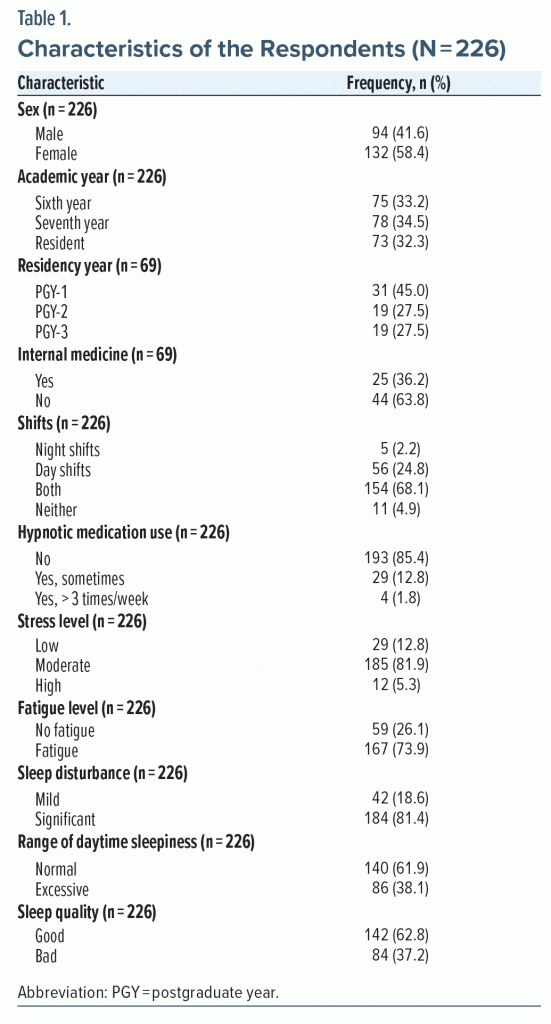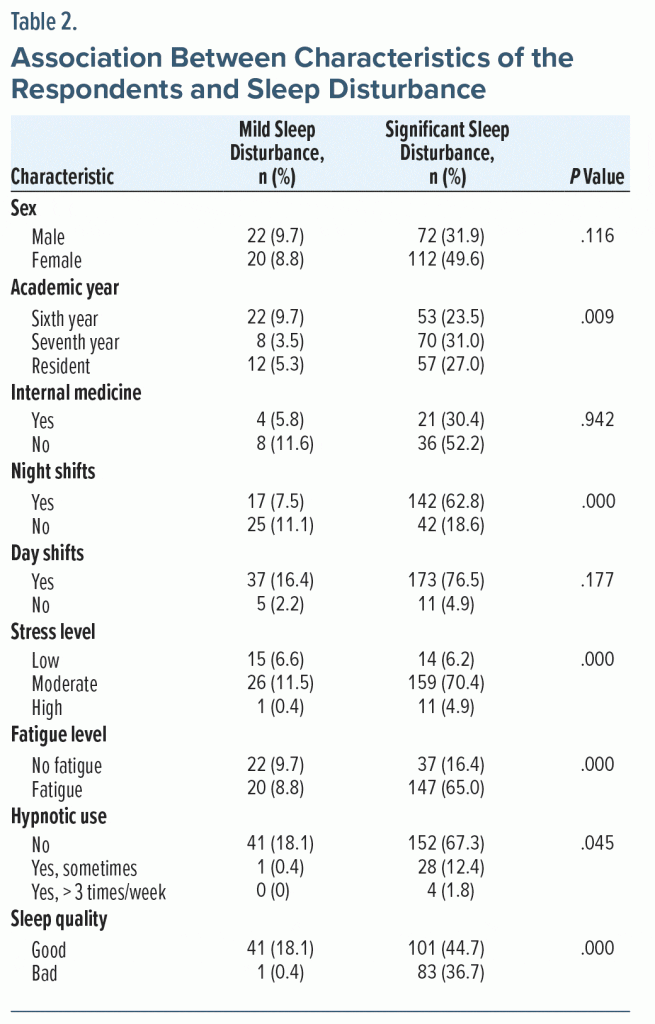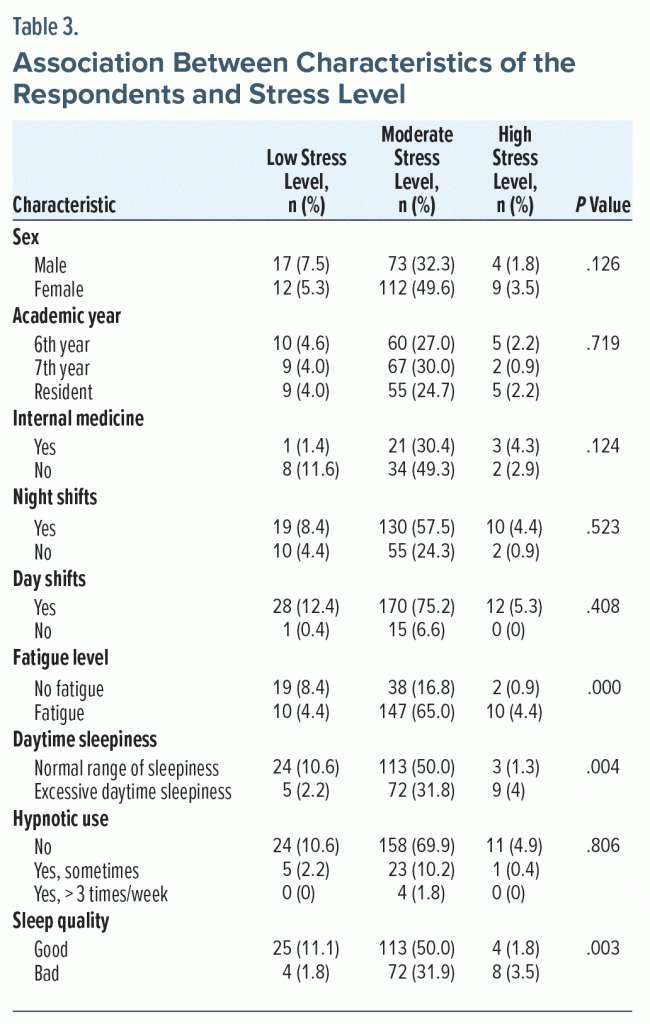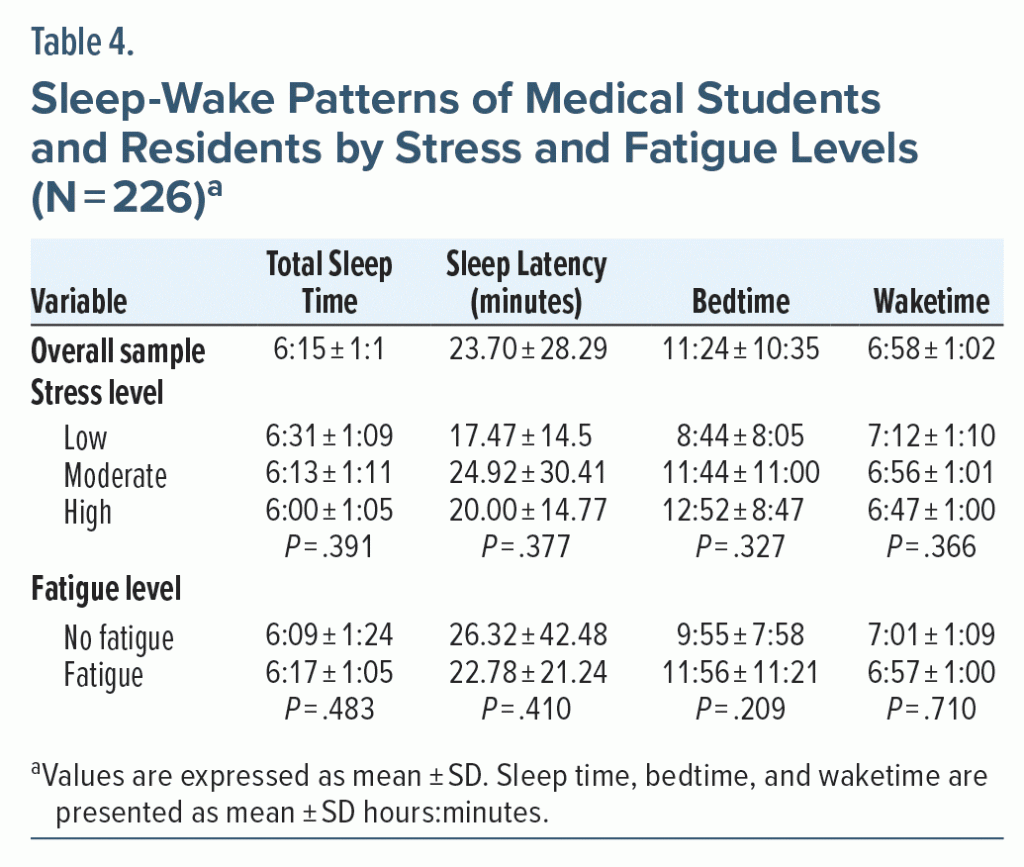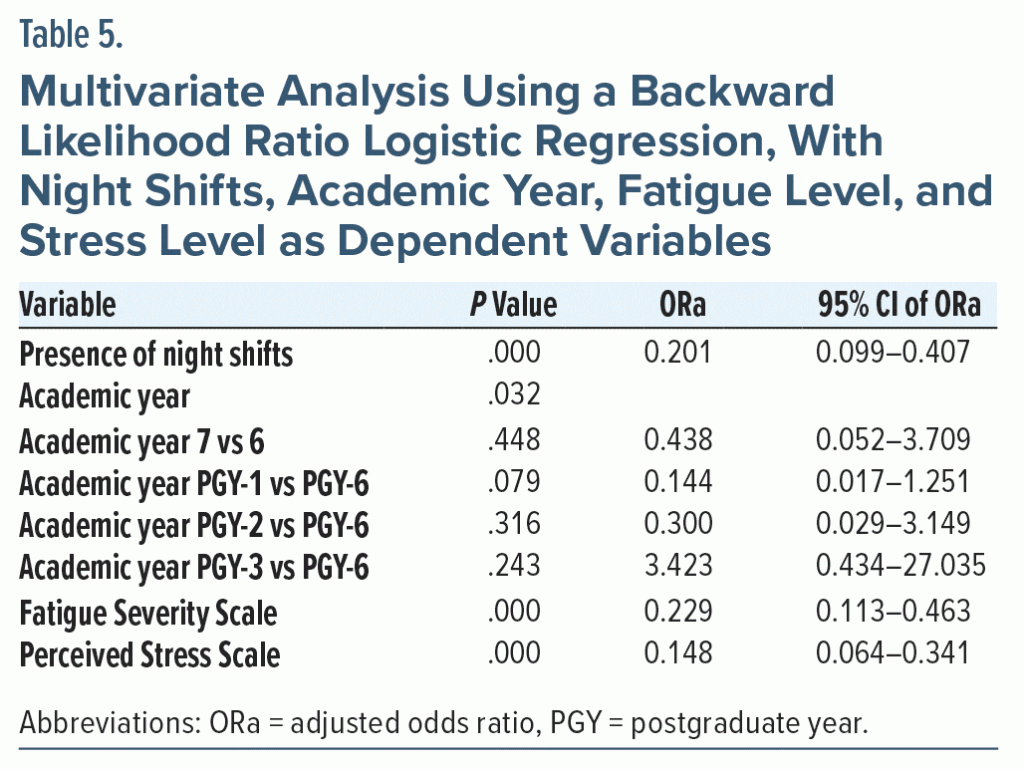
This work may not be copied, distributed, displayed, published, reproduced, transmitted, modified, posted, sold, licensed, or used for commercial purposes. By downloading this file, you are agreeing to the publisher’s Terms & Conditions.
Original Research
Assessment of Sleep Among Lebanese University Medical Trainees During Clinical Years and Association With Shifts, Psychological Stress, and Fatigue
Published: September 12, 2023
ABSTRACT
Objective: To determine the prevalence of sleep disturbance among Lebanese University medical students and residents during their clinical years and investigate associations with night versus day shifts, psychological stress, and fatigue.
Methods: A single-center cross-sectional study was conducted with medical students in their sixth and seventh years of study as well as residents. A total of 226 medical trainees participated in the study. A self-administered questionnaire was distributed electronically in August 2022. The survey included the Pittsburgh Sleep Quality Index to diagnose sleep disturbance levels as well as questions about demographic data and associated factors. The Epworth Sleepiness Scale, Perceived Stress Scale, and Fatigue Severity Scale were also included.
Results: Among 226 participants, the prevalence of significant sleep disturbance was found to be 81%. Academic year (P = .009), night shifts (P < .001), stress (P < .001), fatigue (P < .001), and hypnotic use (P = .045) were found to be associated with sleep disturbance. Of the participants, 82% had moderate stress levels, and 74% were found to have fatigue. Excessive daytime sleepiness was reported in 38% of participants.
Conclusions: The frequency of significant sleep disturbance among the medical students and residents was found to be high. Academic year, night shifts, stress, fatigue, and hypnotic use were associated with sleep disturbance.
Prim Care Companion CNS Disord 2023;25(5):23m03492
Author affiliations are listed at the end of this article.
A healthy and well-maintained quality of sleep is essential for human physical and mental well-being. The average sleep hours per night for adults is 7 hours but varies between individuals.1 It has been shown that loss of sleep can adversely affect mental as well as physical outcomes.2
It is acknowledged that medicine is a tough and tiring domain, and stress and lack of sleep are common among residents and fellows.3 Medical students are highly predisposed to have a disturbed and low quality of sleep due to their huge workload.1 Studies4 conducted among medical residents have shown that long work hours negatively affect patient care, education, and the well-being of residents. These extended work hours and alternating shifts lead to sleep deprivation and partial sleep loss.2 On the contrary, reduced work hours and subsequently more time to sleep improve the quality of life of residents.5
The practical training years that include day and night shifts are an exhaustive phase during which medical students tend to sacrifice sleep to cope, and the amount of time spent sleeping decreases.6 Overnight shifts lead to chronic restriction of sleep.7 Research has shown that interns, residents, and doctors completing fellowships who perform on-call shifts and take additional duties every few days tend to have sleep problems and are sleep deprived.6
Residents who take 24-hour on-call shifts experience more fatigue and are less productive at work than those who do not take night shifts and tend to have more time to sleep.8 Consequently, the fatigue resulting from lack of sleep among medical trainees constitutes a threat to their performance at work.9 A cross-sectional study8 conducted among medical residents concluded that students completing 24-hour on-call shifts had unfavorable physiologic performance and mood indicators compared to those who were not on call.
On the other hand, bad sleep habits and lack of sleep among medical residents were strongly associated with both physical and psychological job stress.10 Lack of sleep affects the mental health of medical trainees, leading to burnout among physicians.11,12 A study13 conducted among female emergency medicine residents in South Korea reported a high prevalence of depression and sleep-wake cycle difficulties. Another study14 carried out with interns found that short sleep constitutes a risk factor for depression. In general, medical students’ wellness is affected by the quality of their sleep.15
Lebanese University medical students face many challenges during their clinical years and have difficult clinical rotations due to their many responsibilities and workload. In addition, the Lebanese University clinical rotations are not well paid, so most of the residents and fellows tend to take extra shifts to make more money. All these factors render Lebanese University medical students sleep deprived; however, this problem is not well known, and studies related to this issue are lacking.
The main objective of this study was to assess sleep among Lebanese University medical students and residents during their clinical years. The secondary objective was to determine the prevalence of sleep disturbance among medical trainees during their clinical years and to investigate associations with night versus day shifts, psychological stress, and fatigue.
METHODS
This was an observational cross-sectional online study of sixth- and seventh-year medical students and residents in their first 3 years at Lebanese University, Beirut, Lebanon. Prior to completing the questionnaire, the students and residents were informed of the study and provided consent to participate.
Setting
In Lebanon, sixth-year medical students are completing clinical rotations to gain hands-on experience in various specialties. They are typically not responsible for managing patients independently. However, they may be expected to participate in patient care under the supervision of more experienced physicians. Seventh-year medical students are responsible for the day-to-day management of patients, including conducting patient assessments, ordering tests, and formulating treatment plans. They may also be responsible for overnight call and managing patients independently under the supervision of more senior residents or attending physicians. Residents are medical trainees who have completed their internship year. Depending on their specialty and program, they may be responsible for managing more complex cases and supervising interns and medical students. They may also be responsible for overnight call and managing patients independently.
Sample
Sixth- and seventh-year medical students as well as students in the first 3 years of residency at the Lebanese University School of Medicine were included in the study. For this group, there were no exclusion criteria. We calculated the appropriate sample size, which was considered a minimum to achieve precise results. To calculate the minimal sample size from the targeted population, we used Slovin’s formula: n = N/(1+N*e^2).
Instruments and Data Collection
Data were collected via a questionnaire through social media platforms and WhatsApp groups, using a snowball technique during August 2022. The online survey was sent once to each study participant and consisted of a link to an internet-based questionnaire on Google Forms. The participants’ phone numbers were taken from the delegate of each class, and they each were contacted separately using the same message. Nonresponders were sent a 1-time message reminder.
To ensure that the participants fully understood the subject and gave their implicit consent, the topic was explained in the descriptive portion of the survey. The questionnaire required between 15 and 20 minutes to complete, was available in English, and comprised 4 sections:
- The first section: sociodemographic and personal data such as age, sex, academic year, night versus day shifts, and number of shifts per week.
- The second section: sleep quality and insomnia assessment using 2 scales, the Pittsburgh Sleep Quality Index,16 which comprises 9 questions to assess sleep quality and disturbances over 1-month duration, and the Epworth Sleepiness Scale to assess daytime sleepiness.17
- The third section: psychological stress assessment using the validated Perceived Stress Scale,18 which is composed of 10 items. This scale asks about feelings and thoughts during the last month to assess for the presence of stress.
- The fourth section: fatigue level assessment using the Fatigue Severity Scale.19 This 9-item self-report questionnaire includes statements related to how fatigue interferes with certain activities and rates severity on a scale of 1–7.
The questionnaire for this study was designed so that the respondents would not feel misled or think the concept was being exaggerated, as its goals and objectives were clearly stated. Moreover, no offensive, discriminatory, or unacceptable language was used.
Validity and reliability of the questionnaire: A pilot study of the questionnaire was conducted with 10%–15% of the population. To obtain accurate and precise results, a test-retest of the validity and reliability of the scales used in the questionnaire was done to make sure that they fit the chosen population. Face validity of the whole questionnaire was tested by 2 experts in questionnaire formulation. For the construct validity, a Pearson correlation test was administered to determine the relationship between the items and the whole scale (total). For all 3 scores, there was a correlation between variables, which was statistically significant:
Pittsburgh Sleep Quality Index. Reliability: α = .712; validity: between r = 0.348 and r = 0.718/P = .05 and P = .01; n = 40.
Epworth Sleepiness Scale. Reliability: α = .871; validity: between r = 0.537 and r = 0.839/P = .05 and P = .01; n = 40.
Perceived Stress Scale. Reliability: α = .7; validity: between r = 0.135 and r = 0.736/P = .05 and P = .01; n = 40.
Fatigue Severity Scale. Reliability: α = .903; validity: between r = 0.363 and r = 0.889/P = .05 and P = .01; n = 40.
Data Analysis
The main outcome of this study was prevalence of sleep disturbance. We assessed the relationship between sleep disturbances and sex, academic year, night/day shifts, stress level, fatigue level, hypnotic use, and sleep quality. We also studied the association between stress level and the above variables to see if the null hypothesis was rejected at a P < .05 level. An individual who was not involved in the data collection process completed the data entry, and data statistical analysis was performed using SPSS 25 for Windows (IBM Corp, Armonk, New York).
A comparison of variables was performed using the independent t test for 2 groups (such as for mild versus significant level of sleep disturbance) and analysis of variance for more than 2 groups (such as low, average, and high level of stress). Both tests were used for numeric variables such as age, number of shifts taken per week, sleep duration, and sleep latency. The χ2 test was used for non-numeric variables such as sex, academic year, day versus night shifts, and sleep quality. A P value < .05 was considered statistically significant. For multivariable analysis, a logistic regression was conducted using a backward stepwise likelihood ratio method, taking all independent variables included in Table 1 as potential confounders.
RESULTS
The target was 226 participants. Of 520 questionnaires sent to medical students and residents, 226 (43.46%) were completed and collected. The remaining 294 students (56.54%) corresponded to nonresponders. Thus, the total sample size was 226 participants.
Table 1 presents the characteristics of the study population. The 226 participants were aged 22–29 years, and 58% were female and 42% were male. Regarding academic year, 33% were in their sixth year, 34% were in their seventh year, and 32% were residents. Among residents, 36% were in the field of internal medicine. Most respondents (68%) reported having both night and day shifts. The majority of participants (85%) reported not having used any hypnotic medication to help them fall asleep during the last month. Of the 15% who used medication, 13% used it once or twice per week. Also, 82% of the participants were found to have moderate stress levels, and 74% were found to suffer from fatigue. Prevalence of disturbed sleep, excessive daytime sleepiness, and sleep quality are also shown in Table 1. Approximately 37% of the students reported that they viewed their sleep quality to be fairly poor or very poor during the previous month. Normal daytime sleepiness was reported by approximately 62% of the students. In terms of sleep disturbance, 82% of students were found to have significant sleep disturbance.
Table 2 shows that the prevalence of significant sleep disturbance among respondents who suffered from fatigue (65%) was much higher than that among those who did not suffer from fatigue (16.4%), with a highly statistically significant difference (P < .001). There was a highly significant association between sleep quality and sleep disturbance (P < .001), as well as sleep latency (P < .001). The prevalence of significant sleep disturbance among respondents who did not use hypnotic medications (67.3%) was much higher than that among those who use these medications (14.2%), with a statistically significant difference (P = .045).
Being in the sixth year of medical school was significantly associated with significant sleep disturbance (P = .009). No association was found between age (P = .105), sex (P = .116), being in the internal medicine field (P = .942), and having day shifts (P = .177) and sleep disturbance. There was a statistically significant association between night shifts and sleep disturbance (P < .001).
Table 3 shows that the prevalence of moderate stress levels among respondents who suffered from fatigue (65%) was much higher than that among those who do not suffer from fatigue (16.8%), with a highly statistically significant difference (P < .001). Regarding sleep quality, there was a statistically significant difference (P = .003) between the frequency of sleep quality among participants with a moderate stress level (50%) and a low/high stress level (12.9%).
The sleep-wake patterns of the overall sample are described in Table 4. The mean ± SD total hours of sleep per night was 6:15 ± 1:1, and sleep latency (time to fall asleep) was 23.70 ± 28.29 minutes. Table 4 also presents respondents’ sleep-wake patterns according to stress level and fatigue. Those with low, moderate, and high levels of stress showed similar patterns of total hours of sleep, sleep latency, bedtime, and wakeup time. There were no significant differences in the sleep-wake habits between those with low, average, and high stress levels or for fatigue.
Using a backward likelihood ratio logistic regression (Table 5), and taking all independent variables as potential confounders, the following results were obtained: taking night shifts significantly increases the risk of having significant sleep disturbance and suffering from stress (9-fold increase) and fatigue (8-fold increase). In addition, being in higher academic years (> seventh year) significantly protects students against sleep disturbance, while being in the sixth year increases the risk by 6- to 7-fold.
DISCUSSION
This study explored some factors that could be associated with sleep. Academic year, night shifts, stress, fatigue, and hypnotic use were found to be associated with sleep disturbance.
In this study, the prevalence of significant sleep disturbance was 81% among the Lebanese University medical students and residents during their clinical years. The high prevalence of significant sleep disturbance among medical students in our study can be related to the obligations and duties of the students in their respective hospitals, especially with the decreased compensation they receive compared to the duties they serve. In addition to the hospital burden, medical trainees, like all other Lebanese citizens, are facing a financial and economic crisis. Similar results were also observed in studies of medical students from King Saud University,20 Saudi Medical College,21 and Universidad Tecnológica de Pereira.22 However, not all studies are in agreement with this finding. For example, lower prevalence was reported among medical students in studies conducted in a Saudi medical school,23 a Saudi highschool,24 and at Mongolia Medical University in China.25 Although these studies23–25 used the same methodological approach (ie, the Pittsburgh Sleep Quality Index), our results are different and the rates much higher. The key is the difference in the time periods during which these studies were conducted. We conducted our study at the end of the COVID-19 pandemic, which was a critical and stressful time for the trainees and might have led to such discrepancies and higher rates of sleep disturbance.
Our study revealed that 37% of medical students subjectively stated that their sleep quality was fairly bad or very bad, which was consistent with the results of Almojali et al.26 However, our results for the Pittsburgh Sleep Quality Index were inconsistent with that of Almojali and colleagues,26 who found a higher percentage of significant sleep disturbance. The cause of such discrepancies could be a lack of knowledge regarding good sleep quality, and thus the students had a misperception of their sleep quality when asked subjectively.
Regarding daytime sleepiness, our study found that 38% of medical trainees suffered from excessive daytime sleepiness. Results of studies by Alsaggaf et al23 and Merdad et al24 are in line with our results. However, Giri et al27 found a lower percentage of interns experiencing abnormal daytime sleepiness (12%). Our study showed an association between daytime sleepiness and stress. All the stress that medical students encounter could cause insomnia and sleep disturbance, which will decrease the quality of sleep and exacerbate sleepiness among medical students. These results are in line with those of a study by Merdad and colleagues.24
There was no significant difference between males and females with respect to sleep disturbance. These results are consistent with those of Almojali et al,26 Safhi et al,28 and El Hangouche et al.29 Although Kische and colleagues30 found clinical evidence that links estrogen to sleep problems, our study found no female predominance. This contrast in findings may be due to cultural differences and ethnicity as well as sampling methods and sample size.
Our study found an association between academic year and sleep disturbance, and most of the medical students with significant sleep disturbance were in the sixth year. This finding could be explained by the new unfamiliar environment and the obligations imposed on their sixth-year students who recently started their clinical rotations, in addition to their academic stress. These results are inconsistent with those of Almojali et al,26 who found that first-year medical students had the poorest sleep quality. Also, no association was found between academic year and sleep in their study26 or in that of Safhi and colleagues.28
Only 14% of medical students reported using hypnotic medication to help them fall asleep in our study, which is in line with findings of 2 studies conducted in Saudi Arabia.23,28 This low percentage may be due to medical students being aware of the side effects and dependence associated with hypnotic medications.
The results of our study revealed an association between night shifts and sleep disturbance. This is in line with a study by Pérez-Olmos and Ibáñez-Pinilla,31 wherein greater sleep deprivation in students was found to be significantly associated with night shift work. This finding could be explained by the irregular sleep cycle of the medical students on call during a night shift, multiple awakenings in the middle of the night, the high workload, and their schedules.
We found that 87% of medical trainees suffered from moderate to high stress levels. This high prevalence of stress could be attributed to multiple etiologies, such as overwhelming responsibilities at the hospital, especially for seventh-year students and residents, and the economic crisis in Lebanon, which has severely affected medical trainees who have not received a raise in their monthly income. Lower prevalence of stress was seen among medical students in previous studies.21,23 Giri and collegues27 found that 30% of interns suffered from stress. The cause of such discrepancies could be the different methodological approaches used in the studies (eg, the Kessler Psychological Distress Scale was used in one study21) and the time period in which they were conducted (eg, our study was conducted during an overwhelming economic crisis and the COVID-19 pandemic).
Our study revealed an association between stress and sleep disturbance, which was also reported in previous studies.20,21,23,28 We also found an association between fatigue and stress, as did Tanaka and colleagues.32
Our study revealed no significant differences in sleep-wake habits between students with low, average, and high stress levels or fatigue. This finding is in line with that a study of medical students in a Saudi medical school.23
Our study does have some limitations. We did not enroll all university medical students in Lebanon in the study, so the results cannot be generalized to all medical trainees in the country. In addition, the self-administered questionnaire might have created miscomprehension of some questions as well as a tendency to rush in filling out the questionnaire. Moreover, this was a cross-sectional study that could not estimate causality between different factors and was prone to recall bias.
CONCLUSION
The frequency of significant sleep disturbance among Lebanese University medical students and residents was found to be high. Academic year, night shifts, stress, fatigue, and hypnotic use were considered as factors associated with sleep disturbance. Medical trainees rated their sleep quality good when asked subjectively, which differed from what was reported based on the Pittsburgh Sleep Quality Index. These findings highlight the need to teach medical students about proper sleep hygiene and the harmful effects of insufficient sleep quantity. Therefore, educational programs are necessary to inform students about sleep hygiene and increase their awareness of it. Quality sleep is important for medical students during their clinical years, as it can affect their motivation and attentiveness when caring for patients. Furthermore, similar research as well studies exploring the specific triggers of poor sleep quality are needed in all medical universities.
Article Information
Published Online: September 12, 2023. https://doi.org/10.4088/PCC.23m03492
© 2023 Physicians Postgraduate Press, Inc.
Prim Care Companion CNS Disord. 2023;25(5):23m03492
Submitted: January 21, 2023; accepted March 31, 2023.
To Cite: Chahine S, Kassem J, Wanna S, et al. Assessment of sleep among Lebanese university medical trainees during clinical years and association with shifts, psychological stress, and fatigue. Prim Care Companion CNS Disord. 2023;25(5):23m03492.
Author Affiliations: Faculty of Medical Sciences, Lebanese University, Beirut, Lebanon (Chahine, Kassem, Wanna, Almawy, Salameh); Faculty of Human Sciences, Lebanese University, Tripoli, Lebanon (Matar); Faculty of Public Health, Lebanese University, Tripoli, Lebanon (Matar); Lille University, School of Medicine, France (Matar); School of Medicine, Lebanese American University, Beirut, Lebanon (Salameh); Institut National de Santé Publique, Epidémiologie Clinique et Toxicology (INSPECT-LB), Beirut, Lebanon (Salameh); University of Nicosia Medical School, Nicosia, Cyprus (Salameh).
Corresponding Author: Sana Chahine, MD, Lebanese University-Faculty of Medical Sciences, Lebanon Koura Kafaraaka, Koura, 0000, Lebanon (Sana_chahine26@hotmail.com).
Relevant Financial Relationships: None.
Funding/Support: None.
Clinical Points
- A high prevalence of significant sleep disturbance was found among Lebanese University medical students and residents during their clinical years.
- Academic year, night shifts, stress, fatigue, and hypnotic use were associated with sleep disturbance.
- This study provides valuable information for medical schools and policymakers to create programs and policies that support the mental health and well-being of medical students, as well as potentially improve their academic performance and overall quality of life.
Quick Links:
$40.00
Buy this Article as a PDF
